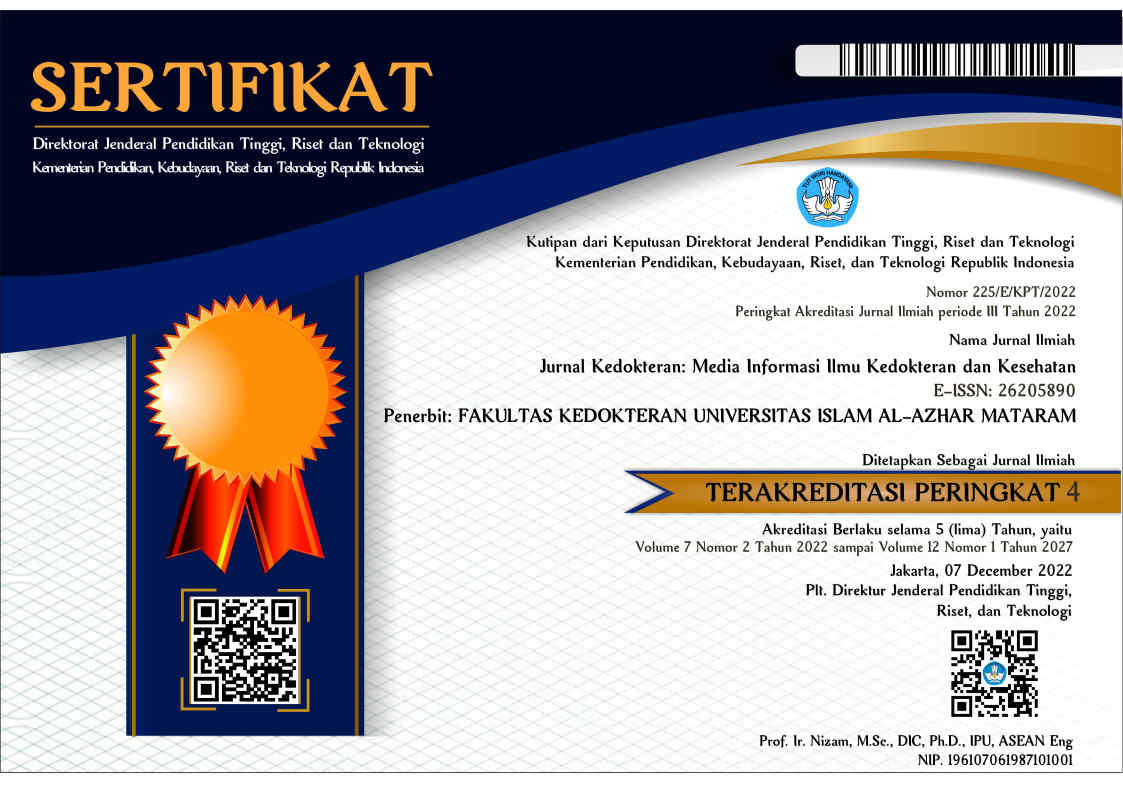Correlation Between icaA/B/C/D Gene and Biofilm Formation in Staphylococcus aureus Infection
DOI:
https://doi.org/10.36679/kedokteran.v9i1.39Keywords:
Staphylococcus aureus, Biofilms, Ica genesAbstract
Staphylococcus aureus is a commensal gram-positive bacterium related to various infections in humans. The ability of S. aureus to form biofilm plays an important role in pathogenesis and the presence of the ica gene is known to be related to this biofilm formation. The study was an analytic cross-sectional study aimed at detecting the presence of the ica gene and its correlation with biofilm formation. The samples in this study were patients with S. aureus infection treated at Prof. Dr. dr. I.G.N.G Ngoerah Hospital from October 2020 to January 2021. The total samples were 67 with a dominant age range was 46-65 years (43.3%) and equal gender amount. The three most common diagnoses of S. aureus infection were post-surgical wound infection (wound swab sample) followed by pneumonia (sputum sample) and chronic kidney disease (blood sample). It was revealed that all isolates produced biofilm with different quantities which were grouped into little (62%), moderate (23.8%), and strong (13.4%) and nearly all samples had at least one ica gene notably icaB or icaD. The icaA gene was detected in 29 samples (43.3%), icaB in 60 samples (89.6%), icaC in 37 samples (55.2%), and icaD in 65 samples (97%). The icaA gene significantly correlated with the quantity of the biofilm formed (p=0.002). The more ica genes the isolate possesses, the more the ability to form biofilms quantitatively (p=0.022).
References
Avila-Novoa, M. G., Iñíguez-Moreno, M., Solís-Velázquez, O. A., González-Gómez, J. P., Guerrero-Medina, P. J., & Gutiérrez-Lomelí, M. (2018). Biofilm Formation by Staphylococcus aureus Isolated from Food Contact Surfaces in the Dairy Industry of Jalisco, Mexico. Journal of Food Quality, 2018. https://doi.org/10.1155/2018/1746139
Boswihi, S. S., Udo, E. E., & AlFouzan, W. (2020). Antibiotic resistance and typing of the methicillin-resistant Staphylococcus aureus clones in Kuwait hospitals, 2016–2017. BMC Microbiology, 20(1). https://doi.org/10.1186/s12866-020-02009-w
Gibson, J. F., Pidwill, G. R., Carnell, O. T., Surewaard, B. G. J., Shamarina, D., Sutton, J. A. F., Jeffery, C., Derré-Bobillot, A., Archambaud, C., Siggins, M. K., Pollitt, E. J. G., Johnston, S. A., Serror, P., Sriskandan, S., Renshaw, S. A., & Foster, S. J. (2021). The Commensal bacteria augment Staphylococcus aureus infection by inactivation of phagocyte-derived reactive oxygen species. PLoS Pathogens, 17(9). https://doi.org/10.1371/journal.ppat.1009880
Gowrishankar, S., Kamaladevi, A., Balamurugan, K., & Pandian, S. K. (2016). In Vitro and in Vivo Biofilm Characterization of Methicillin-Resistant Staphylococcus aureus from Patients Associated with Pharyngitis Infection. BioMed Research International, 2016. https://doi.org/10.1155/2016/1289157
Humaryanto, & Hanina. (2021). Comparison of Three Methods of DNA Extraction for Methicillin Resistant Staphylococcus Aureus (MRSA). JMJ, 10(4), 551–556.
Kwiecinski, J. M., Jacobsson, G., Horswill, A. R., Josefsson, E., & Jin, T. (2019). Biofilm formation by Staphylococcus aureus clinical isolates correlates with the infection type. Infectious Diseases, 51(6), 446–451. https://doi.org/10.1080/23744235.2019.1593499
Lelapi, N., Nucoletti, E., Guasticchi, G., Lore, C., Avenoso, T., Barbetta, A., de Franciscis, S., Andreucci, Mi., Sapienca, P., & Serra, R. (2020). The Role of Biofilm in Central Venous Catheter-Related Bloodstream Infections: Evidence-based Nursing and Review of the Literature. Bentham Science, 15(1), 22–27.
Mahon, C. R., Lehman, D. C., & Manuselis, G. (2019). Textbook of diagnostic microbiology (7th ed.). Elsevier.
Mirzaee, M., Peerayeh, S. N., & Ghasemian, A.-M. (2014). Detection of icaABCD Genes and Biofilm Formation in Clinical Isolates of Methicillin Resistant Staphylococcus aureus. In Iranian Journal of Pathology (Vol. 9, Issue 4).
Neopane, P., Nepal, H. P., Shrestha, R., Uehara, O., & Abiko, Y. (2018). In vitro biofilm formation by Staphylococcus aureus isolated from wounds of hospital-admitted patients and their association with antimicrobial resistance. International Journal of General Medicine, 11, 25–32. https://doi.org/10.2147/IJGM.S153268
Nourbakhsh, F., & Namvar, A. E. (2016). Detection of genes involved in biofilm formation in Staphylococcus aureus isolates. GMS Hygiene and Infection Control, 11, 1–5.
Omar, A., Wright, J. B., Schultz, G., Burrell, R., & Nadworny, P. (2017). Microbial biofilms and chronic wounds. In Microorganisms (Vol. 5, Issue 1). MDPI AG. https://doi.org/10.3390/microorganisms5010009
Omidi, M., Firoozeh, F., Saffari, M., Sedaghat, H., Zibaei, M., & Khaledi, A. (2020). The Ability of biofilm production and molecular analysis of spa and ica genes among clinical isolates of methicillin-resistant Staphylococcus aureus. BMC Research Notes, 13(1). https://doi.org/10.1186/s13104-020-4885-9
Piechota, M., Kot, B., Frankowska-Maciejewska, A., Gruzewska, A., & Woźniak-Kosek, A. (2018). Biofilm Formation by Methicillin-Resistant and Methicillin-Sensitive Staphylococcus aureus Strains from Hospitalized Patients in Poland. BioMed Research International, 2018. https://doi.org/10.1155/2018/4657396
Reffuveille, F., Josse, J., Vallé, Q., Mongaret, C., & Gangloff, S. C. (2017). Staphylococcus aureus Biofilms and their Impact on the Medical Field. In The Rise of Virulence and Antibiotic Resistance in Staphylococcus aureus. InTech. https://doi.org/10.5772/66380
Sagar, S. S., Kumar, R., & Kaistha, S. D. (2016). Biofilm-An Eternalchronicle of Bacteria. Indian Journal of Comparative Microbiology, Immunology and Infectious Diseases, 37(2), 45. https://doi.org/10.5958/0974-0147.2016.00010.6
Sen, C. K., Roy, S., Mathew-Steiner, S. S., & Gordillo, G. M. (2021). Biofilm Management in Wound Care. Plastic and Reconstructive Surgery, 275E-288E. https://doi.org/10.1097/PRS.0000000000008142
Suryanditha, P. A., Rasita, Y. D., Debora, K., & Kuntaman, K. (2018). icaA/D Genes and Biofilm Formation of Methicillin-Resistant Staphylococcus aureus in Dr. Soetomo Hospital, Surabaya. Folia Medica Indonesiana, 54(4), 263. https://doi.org/10.20473/fmi.v54i4.10709
Taylor, TA., & Unakal, CG. (2022). Staphylococcus Aureus. In In: StatPearls [Internet]. Treasure Island (FL): StatPearls Publishing. https://www.ncbi.nlm.nih.gov/books/NBK441868/
Torlak, E., Korkut, E., Uncu, A. T., & Şener, Y. (2017). Biofilm formation by Staphylococcus aureus isolates from a dental clinic in Konya, Turkey. Journal of Infection and Public Health, 10(6), 809–813. https://doi.org/10.1016/j.jiph.2017.01.004
York, N., San, C., Athens, F., Madrid, L., City, M., Riedel, S., Hobden, J. A., Miller, S., Morse, S. A., Mietzner, T. A., Detrick, B., Mitchell, T. G., Sakanari, J. A., & Hotez, P. (2019). Jawetz, Melnick Adelberg’s Medical Microbiology 28th edition. McGraw Hill. www.mhprofessional.com.
Downloads
Published
How to Cite
Issue
Section
License
Copyright (c) 2023 Marta Setiabudy, I Ketut Agus Indra Adhiputra, Agus Eka Darwinata, Ni Nengah Dwi Fatmawati

This work is licensed under a Creative Commons Attribution-NonCommercial 4.0 International License.







